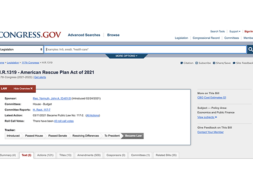
Beginning to Make Sense of the New Borrower Defense Regulations
By Michael T. Wherry, CPA, McClintock & Associates
Summer has ended, you should be familiar with never-ending road construction projects. In many cases, doesn’t it seem like the same section of road was replaced or changed just a few years ago and now it is being reconstructed again? Right? I am not a civil engineer, but I assume road construction projects are dependent on government funding, budgets, and administration (state and local) priorities. Doesn’t this sound similar to the borrower defense to repayment regulations? An overhaul of a recent regulation.
After committing two years ago to making significant changes to the borrower defense to repayment regulations, the Department of Education (ED) released finalized rules on Sept. 23 clarifying existing pieces and overhauling many other facets. While these changes affect the nature of claims, procedural steps and regulations related to those areas in a legal sense, a number of the new regulations affect accounting and regulatory issues — notably, the rules regarding financial responsibility.
The finalized regulations will be effective for federal student loans first disbursed on or after July 1, 2020. An option exists to early adopt Section 668.172(d), Appendix A to Subpart L of Part 668, and Appendix B to Subpart L of Part 668 as of the Date of Publication in the Federal Register which relates to the composite score calculation.
In this summary, we will review the regulations applicable mainly to the financial responsibility standards beginning with the triggering events and then discussing changes to the composite score ratio (CSR).
This summary represents McClintock & Associates most recent understanding of the issued regulations. We currently have sent specific questions regarding some of the changes to officials at ED and, thus, our understanding and interpretation of the regulations may change. Management should consult with their regulatory and financial advisors as to the specific impact on their institution.
Triggering events
The triggering events were established in the 2016 regulations, as ED believed more contemporaneous information is necessary to prevent precipitous closures since audited financial statements are only provided annually. The triggering events are established to enable ED to be aware of critical financial events, when these events occur, and not having to wait to receive the audited financial statements. (Reminder that audited financial statements can be filed up to six months after year-end for a proprietary institution and up to nine months after year-end for a nonprofit institution). ED still believes the triggering event reporting is important and, according to ED, the new regulations will provide fair, clear and verifiable financial triggers for recalculating an institution’s financial CSR or prompting financial protection. We believe this is a positive change from the 2016 regulations, as uncertain or undefined events will no longer be reported, and institutions will be reporting events with quantifiable or known outcomes.
The regulations define mandatory and discretionary triggers. If two discretionary triggers occur for an institution, those events become mandatory events unless a triggering event is resolved before any subsequent event(s) occur. ED will recompute the CSR by using an institution’s most recently submitted annual audited financial statements and the quantifiable amount from the triggering event(s). If an event causes the CSR to drop below 1.0, the institution is deemed not to be financially responsible. If the CSR is above 1.0 and below 1.5, no change in financial responsibility occurs. Institution do have the ability to provide information which mitigates the potential financial risk when the triggering event is reported (i.e., insurance coverage for a lawsuit).
A CSR below a 1.0 will most likely require a 50% letter of credit or a 10% letter of credit along with Heightened Cash Monitoring 1 and a Provisional Program Participation Agreement. As a reminder, a triggering event needs to be reported to ED (fsafrn@ed.gov) within 10 days. Institutions need to ensure that all key members of management (President, Financial Aid Officer, Compliance Officer, Chief Financial Officer, etc.) are familiar with the triggering events. With only having a 10-day window for reporting, these events need to be identified, a complete set of facts gathered and reviewed, and the reportable event discussed with regulatory counsel/external auditor in a short period of time.
We recommend creating a chart of the triggering events for all key members of management.
Table 2 on page 665 of the official regulations has a chart of the Financial Responsibility Triggers.
Reportable mandatory triggers are as follows:
- Liabilities are incurred by an institution, including but not limited to those arising from a settlement, final judgement or final determination from an administrative or judicial action or proceeding initiated by a federal or state entity. This includes borrower defense claims. It’s also important to note that ED’s definition of “settlements” is undefined, so it’s uncertain if it includes tuition waivers, FDL voluntary refunds or informal settlements with a student. Litigation which is only pending no longer has to be reported.
- This trigger is only required if the current CSR is below 1.5. – Withdrawal of an owner’s equity from the institution may also be a mandatory event, unless the withdrawal is a transfer to an entity included in the affiliated entity group upon whose basis the institution’s CSR was calculated. This means institutions will need to closely monitor all changes in equity, related party receivables and guaranteed wage payments for partnerships to determine reportable events if the CSR is below a 1.5. A change in a related party receivable needs to be reported whether the receivable is secured or unsecured. Therefore, timely and accurate internal monthly financial statements are a must. We believe that under reporting or non-timely reporting of changes in related party accounts receivable is a risk for many institutions.
- For publicly traded institutions, the Securities and Exchange Commission (SEC) issues an order suspending or revoking the registration of the institution’s securities or suspends trading of the institution’s securities on any national securities exchange, the national securities exchange notifies the institution that it is not in compliance with the exchange’s listing requirements and the institution’s securities are delisted, or the SEC is not in timely receipt of a required report and did not issue an extension to file the report.
Discretionary triggers are as follows:
- The institution’s accrediting agency issues an order, such as a show-cause order or similar action, that could result in the loss of institutional accreditation. Actions that don’t risk the loss of licensure (i.e., accreditor teach-out plan for a location) no longer need to be reported.
- The institution fails to meet the 90/10 requirement for one year. (This failure needs to be reported within 45 days from year-end). This was a mandatory trigger under the 2016 regulations.
- The institution’s two most recent official cohort default rates are 30% or greater, unless it files a challenge that results in lowering either rate. This was a mandatory trigger under the 2016 regulations.
- The institution has high annual dropout rates as calculated by ED. (ED included this trigger in the regulations even though it is undefined. Congress has identified high drop-out rates as an area of significant concern).
- The institution violates a provision or requirement in a security or loan agreement with a creditor. Regardless of whether they are waived or remedied, ED believes all violations are potentially significant and must be reported. In cases where the creditor waives a violation without imposing new requirements or restrictions, the institution simply reports that outcome. Institutions should remember that a loan violation could occur more often then annually (i.e., quarterly) depending on the specific requirements in the credit facility agreement.
- The institution’s state licensing or authorizing agency notifies the institution that it has violated a requirement and it intends to withdraw or terminate the institution’s licensure or authorization if the institution does not take the steps necessary to come into compliance. The new regulations have a more targeted approach than the 2016 regulations. ED’s goal with this triggering event is to better identify State or agency actions that are likely to have an adverse financial impact on institutions and to reduce the reporting burden on institutions and the burden on ED in reviewing citations. However, ED does believe that narrowing the meaning of the term to exclude other State agencies, such as boards of nursing, would inappropriately weaken the effectiveness of the trigger, particularly in cases where programs are licensed by those other agencies or boards.
Triggers that are included in the 2016 regulations and are being eliminated by the new regulations are as follows: accreditor required teach-outs, gainful employment, significant fluctuations in Pell grants and Federal Direct Loan funds, financial stress test developed or adopted by ED, and anticipated borrower defense to repayment claims.
Management should understand that auditors review overall compliance with the financial responsibility standards as part of the financial statement audit of an institution. The financial statement audit includes an opinion on Compliance and Other Matters as required under Government Auditing Standards. During our financial statement audit we will perform audit procedures to ensure that proper borrower defense to repayment reporting has occurred, when applicable. Audit procedures could include interviews with client personnel, review of legal invoices, review of the compliance audit workpapers, and other tests deemed necessary by the auditor. A triggering event that is not reported and that the auditor deems to be material to the audited financial statements (quantitative or qualitative) could lead to a compliance finding in the audited financial statements.
Financial ratios
The other key area which ED addressed in the new regulations relating to the financial responsibility standards is the composite score calculation. ED made a significant change regarding the treatment of leases, stemming from the Financial Accounting Board’s (FASB) accounting standards update (ASU 2016-02, Leases) that requires most operating leases to be recognized as assets and liabilities on a company’s balance sheet. Currently, operating lease future commitments are only reflected in the notes to the financial statements as an item of disclosure and only a capital lease is currently reflected as an asset and a liability on the balance sheet. Under 2016-02, a company will recognize a Right-to-Use Asset (RUA) and a Lease Liability (LL) on the balance sheet which will generally be computed based upon the present value of the future lease commitments. The CSR was developed in the mid-1990s, long before ASU 2016-02 was ever contemplated. As such, ED needed to create a “fix” for the CSR as no guidance existed to instruct institutions on how to treat the changes required by ASU 2016-02 in the CSR. FASB has proposed to delay the implementation of ASU 2016-02 for nonpublic companies for one year and, if approved, the ASU would be effective for years beginning after Dec. 15, 2020. (ASU 2016-02 became effective for years beginning after Dec. 15, 2018 for publicly traded companies and companies with conduit debt obligations).
ED’s solution was to “grandfather” in leases entered into prior to Dec. 15, 2018.
Therefore, all operating leases entered into prior to Dec. 15, 2018, will continue to be treated as operating leases and exclude the RUA and LL from the CSR.
Thus, pre-Dec. 15, 2018 lease RUAs and LLs will never be included in the CSR until they are extended or renewed. All new leases or lease changes after Dec. 15, 2018, will be included in the CSR as the RUA will be Property, Plant and Equipment (PP&E) and the LL will be long-term debt. As a reminder, the CSR has three components: Primary Reserve Ratio (adjusted equity divided by total expenses and losses), Equity Ratio (modified equity divided by modified assets), and Net Income Ratio (income before taxes divided by total revenues and gains). Thus, while the impact on the Primary Reserve Ratio should be limited as the RUA and LL amounts will not be materially different, the impact to the Equity Ratio is significant as modified assets (denominator) will increase by the RUA. The impact to the Net Income Ratio should be limited. M&A is clarifying with ED officials, that leases entered into or amended after Dec. 15, 2018, are only included in the CSR once ASU 2016-02 is effective.
From our internal calculations, the CSR could potentially decrease by 0.2 – 0.3 especially for an institution in which the existing CSR is 2.5 or less. As you can see, this change can have a significant impact on the CSR. Institutions need to consider the impact to the CSR as new leases are structured as these leases will eventually be included in the modified assets in the Equity Ratio. Institutions for which the current CSR is below a 2.0 have an even higher risk of negative consequences.
ED didn’t limit the composite ratio changes solely to the new lease standard. In the 2018 proposed regulations, ED expressed concern over the manipulation of the CSR using long-term debt. This was partially a result of an Office of Inspector General’s report surrounding the use of long-term debt in the CSR. Consequently, the new regulations now require that long-term debt must be used specifically for the acquisition of PP&E to be treated favorably in the primary reserve ratio in the composite score calculation. In the Primary Reserve Ratio, to compute adjusted equity, the net book value of PP&E is subtracted from equity and the amount of long-term debt, only up to the net book value of PP&E, is added-back to equity. ED believes reverting back to the original intent of adding debt obtained for long-term purposes solely related to PP&E to the numerator of the primary reserve ratio is the proper approach because it results in a more accurate portrayal of an institution’s financial health. The regulations define “qualified debt” as long-term debt which was specifically used to acquire PP&E. If debt is not deemed to be “qualified” it can’t be added-back to equity which means the numerator in the Primary Reserve Ratio will be a lower number.
Thus, ED has effectively repealed Dear Colleague Letter GEN-03-08 in its treatment of long-term debt, but it acknowledged some type of phase-in is necessary. As a result, all long-term debt memorialized on the audited financial statements submitted to ED prior to June 30, 2020, will be treated as qualified long-term debt. Any subsequent long-term debt must be specifically tied to PP&E and documented, as such, in the audited financial statements to be treated as qualified debt. ED did acquiesce that short-term financing for construction in progress (CIP) will be included in the primary reserve ratio up to the amount of the CIP and only to the extent that the short-term financing is directly related to the CIP. This is beneficial to an institution that has a large construction project (i.e., building, leasehold improvements) under a short-term construction loan which will then be termed-out as permanent debt once the project is completed.
The audited financial statements will have expanded disclosures in order for ED to understand which leases are before Dec. 15, 2018 (pre-implementation) and which leases are post-implementation (after Dec. 15, 2018). Similarly, an institution must clearly define in the audited financial statements each debt instrument as pre-implementation or post-implementation. An institution must disclose in a note to its financial statements, for each pre- and post-implementation debt, the terms of its notes and lines of credit that include the beginning balance, actual payments and repayment schedules, ending balance, and any other changes in its debt including lines of credit. Information must also be presented in a new Supplemental Schedule which will assist institutions and ED in defining the items which are included in the CSR. This Supplemental Schedule will be included in the financial statements most likely as supplementary information. Appendix A to Subpart L of part 668 has the Supplemental Schedule for for-profit institutions and Appendix B to Subpart L of part 668 has the Supplemental Schedule for nonprofit institutions. Institutions and/or their auditors will need to spend additional time ensuring leases and debt are tracked, disclosed, and included properly in the audited financial statements to ensure the CSR is computed accurately.
From our understandings of the regulations, any institution other than a June 30 year-end could borrow new long-term debt which will deemed to be qualified as long as the audited financial statements are submitted to and accepted by ED prior to June 30, 2020. Consequently, management has a limited window for the grandfathering of any long-term debt before the new regulations are effective. (As a caveat, this is one of the questions we have posed to ED officials via our industry contacts and are awaiting specific clarification on this point). In light of the significant changes to the CSR and the potential planning opportunities, in most instances, we see no benefit in early adopting the regulations related to 668.172(d).
Financial protection and institutional liability
As a CPA firm, our focus has been mainly related to the financial responsibility standards as a result of the new regulations. However, we did note the following items as well which have a potential financial impact on an institution.
ED codified current practices that, under procedures established by ED or as part of an agreement with an institution, ED may use the funds from a letter of credit or other financial protection to satisfy the debts, liabilities, or reimbursable costs owed to ED that are not otherwise paid directly by the institution, including costs associated with teach-outs as allowed by ED. Thus, ED is considering allowing other forms of financial protection such as a performance bond.
ED declined, for now, to include a specific methodology for relief on claims asserted under the misrepresentation standard.
However, as ED’s standard for borrower defense claims will require borrowers to demonstrate financial harm and state the amount of that harm, ED believes it will be able to make appropriate relief determinations of financial harm based upon the information in the borrower’s application, the school’s response, the borrower’s reply, and any evidence otherwise in the possession of ED that was provided to both the school and the borrower. ED disagreed that a cap on institutional liability for an approved borrower defense application should exist. ED believes it is appropriate to require an institution to pay the amount of relief provided in the borrower defense process based upon the institution’s act or omission. In the separate recovery proceeding against the institution brought under 34 CFR part 668, subpart H, the institution will have the opportunity to dispute the amount of the liability. The final regulations reflect that ED’s awards of relief will be equivalent to the financial harm incurred by the borrower, and some awards may exceed the alleged financial harm. ED’s award of relief, however, may not exceed ED’s own determination of financial harm.
The takeaway for institutions is that BDTR liabilities, if applicable, will be determined based on when the claims are filed and the amount of harm claimed by the borrower may not match what is awarded in an approved application. Because institutions will be able to dispute these awards, it is a best practice to ensure all appropriate records and documentation are maintained to support your response to any claim.
Next steps
The finalized borrower defense to repayment regulations will be making major changes or modifying and clarifying existing rules. With less than a year before they become effective, institutions have some time to plan for their implementation, but preparation should begin now. M&A has sent questions regarding the lease and long-term debt regulations to ED officials and will keep the broader community advised as answers and clarifications are received. At McClintock & Associates, we are here to guide you in understanding and implementing these new regulations and all others.
MICHAEL WHERRY is a Certified Public Accountant who has 25 years of experience providing a full range of client service and consulting services in the public sector to postsecondary schools which include financial statement audits, Title IV compliance audits, agreed-upon-procedure attestation engagements for regulatory requirements, 90/10 calculation reviews, composite score projections and planning, financial statement reporting, consulting and understanding of new accounting requirements, transaction services for buyer/sellers, internal control processes and procedures, and coordination with Tax Department on tax savings and opportunities. He has presented at regional and national industry conferences in regard to regulatory and audit issues affecting postsecondary institutions.
Prior to joining McClintock & Associates in 1991, Mr. Wherry worked for Deloitte. In addition to his professional responsibilities, Mr. Wherry is the treasurer of the East Liberty Family Health Care Center in the city of Pittsburgh and has earned the honor of Eagle Scout. He resides in Pittsburgh, Pa. with his wife and two sons. Michael Wherry can be contacted by email at mwherry@mcclintockcpa.com or on LinkedIn.
Contact Information: Michael Wherry, CPA // McClintock & Associates // mwherry@mcclintockcpa.com // https://www.linkedin.com/in/mike-wherry-a542259/











